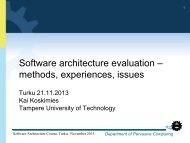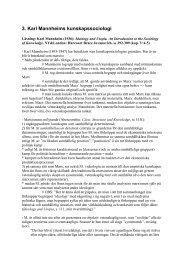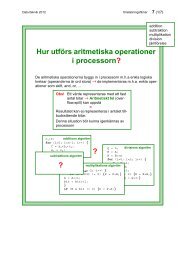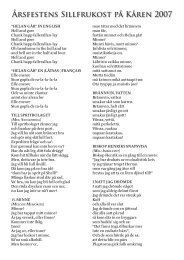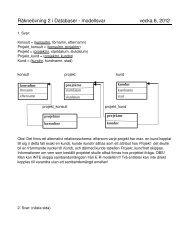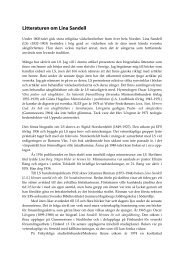Lecture 9 - Åbo Akademi
Lecture 9 - Åbo Akademi
Lecture 9 - Åbo Akademi
You also want an ePaper? Increase the reach of your titles
YUMPU automatically turns print PDFs into web optimized ePapers that Google loves.
Special Course in Computer Science:<br />
Local Networks<br />
<strong>Lecture</strong> 9<br />
9.5.2012
Roadmap of the Course<br />
• So far<br />
• Basic telecom concepts<br />
• General study of LANs<br />
• Local Networks<br />
• Ethernet<br />
• Token bus<br />
• Token ring<br />
• ATM LAN<br />
• Wi-Fi<br />
• LAN performance, connecting LANs, LAN management<br />
• Today<br />
• Networks-on-Chip (NoC)<br />
• Next<br />
• <strong>Åbo</strong> <strong>Akademi</strong>’s local network (Friday 11.5) – Jan Wennström<br />
• Sensor networks (Wednesday 16.5 or Friday 18.5) – Maryam Kamali<br />
• Efficiency in ÅA’s network, Bluetooth, Personal networks, etc<br />
(remaining date)
Network-on-Chip (NoC)<br />
Why NoC<br />
OCP Standard<br />
Fundamentals of NoC<br />
Emerging NoC Paradigms
Why<br />
• Microprocessor<br />
• Critical for computer technology<br />
• Connects computational engine to a memory system<br />
• Multiple technologies<br />
• Dedicated functional units added<br />
• ASICs (application specific integrated circuits)<br />
• SoC born (System-on-Chip)<br />
• Became more complex<br />
• On-chip communication difficult<br />
• Hard for buses to maintain performance at reasonable cost<br />
• Design productivity affected too
From simpler to more complex chips
On-chip communication
Problems to solve<br />
• Cores that perform different functions work at<br />
different clock frequencies<br />
• Graphics processing<br />
• Digital signalling<br />
• Communication over larger area => latency<br />
• Processor shrink but contain more transistor and<br />
cores => interconnection more complex<br />
• Power<br />
• Performance
Some driving forces: Scalability<br />
• Bus technology not very scalable with respect to<br />
• High performance<br />
• Effective on-chip communication<br />
• Reasonable cost<br />
• Segmenting buses<br />
• Bus: long wire, globally clocked, stretching on whole chip<br />
• Bus segments: separate groups of locally clocked, bundled<br />
wires, BRIDGED with each other at each end<br />
• Difficult for complex SoCs and multicore chips<br />
• Need manual design for different segments suiting specific chip<br />
architectures (core placements and configurations)<br />
• Expensive and time-consuming
Some driving forces<br />
• Technical Issues<br />
• Wires get closer to one another => physical problems<br />
leading to bad bus performance<br />
• Parasitic capacitance<br />
• Unwanted storage of an electrical charge between close wires<br />
• Design Productivity gap<br />
• Increasingly smaller transistors => more fit on chips
NoC in a nutshell<br />
• First NoC research from Philips, 2001<br />
• Circuit-switching<br />
• Could advantage e.g., high-performance computing<br />
• Dedicated circuits => increased bandwidth efficiency<br />
• No routing flexibility => network congestion: problem<br />
• Packet-switching<br />
• NIU (network interface units) make the packets from<br />
intercore data<br />
• Routers and switches connect cores via copper wiring<br />
• Routing algorithms and tables<br />
• Routing: simple logic to save host-chip performance, power<br />
• Host-chip limitations => small, energy-efficient, fast routers needed
NoC illustration
Networking techniques<br />
• On-chip communication should be<br />
• Very fast, latency-free, flexible => simple networking =><br />
trade-offs (fewer capabilities)<br />
• TCP/IP does not work<br />
• Too much latency<br />
• Open Core Protocol International Partnership<br />
• OCP standard for on-chip communications<br />
• Proprietary approaches<br />
• NoC Transaction and Transport protocol<br />
• Universal data-translation protocol for intercore communication<br />
• From Arteris chip designer
OCP standard for<br />
on-chip communications
OCP for on-chip communication<br />
• Standard => not have to repeatedly define, verify,<br />
document, support proprietary interface protocols<br />
• Reusable IP cores<br />
• Clearly delineated design boundaries<br />
• Simplifies system verification and testing<br />
• Boundary can be observed, controlled, validated<br />
• Optimized die area<br />
• Any on-chip interconnect can be interfaced to OCP:<br />
• Dedicated p2p communication (eg, pipelined signal<br />
processing applications – video encoding)<br />
• Simple slave-only applications (eg, slow peripheral<br />
interfaces)<br />
• High-performance, latency sensitive, multi-threaded<br />
applications
OCP Characteristics<br />
• IP Core<br />
• Simple peripheral core or high-performance<br />
microprocessor or on-chip communication subsystem<br />
(wrapped on-chip bus)<br />
• OCP defined a point-to-point interface between 2<br />
communicating entities<br />
• One entity: master<br />
• Can present commnads, is controlling<br />
• One entity: slave<br />
• Responds to commands: accepts data or presents data<br />
• For p2p communication: 2 OCP instances
Wrapped Bus and OCP instances
Flexibility of OCP<br />
• Several useful models of how existing cores<br />
communicate with each other<br />
• Pipelining<br />
• Improves bandwidth and latency characteristics<br />
• Mutiple-cycle access models<br />
• Signals are held static for several clock cycles to simplify timing<br />
analysis and reduce implementation area<br />
• Synchronous handshake signals<br />
• Master and slave control when sugnals are allowed to change<br />
• Highly configurable interface<br />
• Data flow, control, verification and test signals
Some fundamental OCP concepts:<br />
Commands<br />
• Commands<br />
• Read, Write, WriteNonPost, Broadcast, ReadExclusive,<br />
ReadLinked, WriteConditional<br />
• WriteNonPost<br />
• Explicitly instructs slave not to post a write<br />
• Broadcast<br />
• Master indicates it attempts to write to several/all remote targets<br />
connected to the other side of a slave<br />
• Synchronization between system initiators<br />
• ReadExclusive: paired with Write/WriteNonPost, blocking<br />
semantics<br />
• ReadLinked: paired with WriteConditional: non-blocking<br />
semantics
Some fundamental OCP concepts:<br />
Address/Data<br />
• OCP address: 1 byte<br />
• Many IP cores have data field widths much greater<br />
than 1 byte<br />
• Configurable data width<br />
• Chosen data field width: word size of the OCP<br />
• A word is the natural transfer unit of the block<br />
• OCP word sizes<br />
• power-of-two and non-power-of-two (needed for 12-bit DSP core)
Some fundamental OCP concepts:<br />
Pipelining, Response, Burst<br />
• Pipelining<br />
• Of transfers<br />
• Returning read data can be delayed after presentation of<br />
respective pipelined request<br />
• Response<br />
• Slave can accept command request from master on one<br />
cycle and respond in a later cycle<br />
• Pipelining<br />
• Responses for Write commands or completing them<br />
immediately without explicit responses<br />
• Burst<br />
• set of transfers linked together into a transaction having<br />
defined address sequence and number of transfers<br />
• Imprecise, precise, single
Some fundamental OCP concepts:<br />
In-band Information, Tags<br />
• Core-specific information can be passed in-band<br />
• in company with other information being exchanged<br />
• for requests and responses, read and write data<br />
• Exp: pass cacheable information<br />
• Tags<br />
• Control the ordering of responses<br />
• Links the response back to the original request<br />
• Without tags<br />
• Slave must return responses in the order the requests were issued by the<br />
master<br />
• Writes must be committed in order<br />
• With tags<br />
• responses can be returned out-of-order and write data can be committed<br />
out-of-order with respect to requests<br />
• as long as the transactions target different addresses
Some fundamental OCP concepts:<br />
Threads<br />
• Support for concurrency and out-of-order processing<br />
of transfers<br />
• Transactions within different threads<br />
• no ordering requirements<br />
• independent flow control from one another<br />
• Within a single thread of data flow<br />
• OCP transfers remain ordered unless tags are in use<br />
• Threads and tags hierarchical<br />
• Each thread has its own flow control<br />
• Ordering within a thread either follows the request order<br />
strictly or is governed by tags
Some fundamental OCP concepts:<br />
Sideband signalling<br />
• Moving data between cores: central<br />
• Other communication types also important<br />
• Different types of control signalling<br />
• Dedicated point-to-point data communication<br />
• Notification of errors unrelated to address/data transfers<br />
• Reporting errors<br />
• The error response code in the response field describes errors<br />
resulting from OCP transfers that provide responses<br />
• Write-type commands without responses cannot use the in-band<br />
reporting mechanism<br />
• Out-of band error fields<br />
• signals report more generic sideband errors, including those<br />
associated with posted write commands
Fundamentals of NoC
Introduction<br />
• Network-on-chip (NoC) is a packet switched on-chip<br />
communication network designed using a layered methodology<br />
• “routes packets, not wires”<br />
• NoCs use packets to route data from the source to the<br />
destination PE via a network fabric that consists of<br />
• switches (routers)<br />
• interconnection links (wires)
Introduction<br />
• NoCs are an attempt to scale down the concepts of<br />
largescale networks, and apply them to the embedded<br />
system-on-chip (SoC) domain<br />
• NoC Properties<br />
• Regular geometry that is scalable<br />
• Flexible QoS guarantees<br />
• Higher bandwidth<br />
• Reusable components<br />
• Buffers, arbiters, routers, protocol stack<br />
• No long global wires (or global clock tree)<br />
• No problematic global synchronization<br />
• GALS: Globally asynchronous, locally synchronous design<br />
• Reliable and predictable electrical and physical properties
Introduction<br />
• ISO/OSI network protocol stack model
NoC Topology<br />
• Direct Topologies<br />
• each node has direct point-to-point link to a subset of other nodes<br />
in the system called neighboring nodes<br />
• nodes consist of computational blocks and/or memories, as well<br />
as a NI block that acts as a router<br />
• e.g. Nostrum, SOCBUS, Proteo, Octagon<br />
• as the number of nodes in the system increases, the total<br />
available communication bandwidth also increases<br />
• fundamental trade-off is between connectivity and cost
NoC Topology<br />
• Most direct network topologies have an orthogonal<br />
implementation, where nodes can be arranged in an<br />
n-dimensional orthogonal space<br />
• routing for such networks is fairly simple<br />
• e.g. n-dimensional mesh, torus, folded torus, hypercube, and octagon<br />
• 2D mesh is most popular topology<br />
• all links have the same length<br />
• eases physical design<br />
• area grows linearly with the number<br />
of nodes<br />
• must be designed in such a way as to<br />
avoid traffic accumulating in the<br />
center of the mesh
NoC Topology<br />
• Torus topology, also called a k-ary n-cube, is an n-<br />
dimensional grid with k nodes in each dimension<br />
• k-ary 1-cube (1-D torus) is essentially a ring network with k nodes<br />
• limited scalability as performance decreases when more nodes<br />
• k-ary 2-cube (i.e., 2-D torus) topology is<br />
similar to a regular mesh<br />
• except that nodes at the edges are connected<br />
to switches at the opposite edge via wraparound<br />
channels<br />
• long end-around connections can, however,<br />
lead to excessive delays
NoC Topology<br />
• Folding torus topology overcomes the long link<br />
limitation of a 2-D torus<br />
• links have the same size<br />
• Meshes and tori can be extended by adding bypass links<br />
to increase performance at the cost of higher area
NoC Topology<br />
• Octagon topology is another example of a direct network<br />
• messages being sent between any 2 nodes require at most two<br />
hops<br />
• more octagons can be tiled together to accommodate larger<br />
designs<br />
• by using one of the nodes is used as a bridge node
NoC Topology<br />
• Indirect Topologies<br />
• each node is connected to an external switch, and switches have<br />
point-to-point links to other switches<br />
• switches do not perform any information processing, and<br />
correspondingly nodes do not perform any packet switching<br />
• e.g. SPIN, crossbar topologies<br />
• Fat tree topology<br />
• nodes are connected only to the leaves of the tree<br />
• more links near root, where bandwidth requirements are higher
NoC Topology<br />
• k-ary n-fly butterfly network<br />
• blocking multi-stage network – packets may be temporarily<br />
blocked or dropped in the network if contention occurs<br />
• k n nodes, and n stages of k n-1 k x k crossbar<br />
• e.g. 2-ary 3-fly butterfly network
NoC Topology<br />
• (m, n, r) symmetric Clos network<br />
• three-stage network in which each stage is made up of a number of<br />
crossbar switches<br />
• m is the no. of middle-stage switches<br />
• n is the number of input/output<br />
nodes on each input/output switch<br />
• r is the number of input and output<br />
switches<br />
• e.g. (3, 3, 4) Clos network<br />
• non-blocking network<br />
• expensive (several full crossbars)
NoC Topology<br />
• Benes network<br />
• rearrangeable network in which paths may have to be rearranged to<br />
provide a connection, requiring an appropriate controller<br />
• Clos topology composed of 2 x 2 switches<br />
• e.g. (2, 2, 4) re-arrangeable Clos network constructed using two (2,<br />
2, 2) Clos networks with 4 x 4 middle switches
NoC Topology<br />
• Irregular or ad hoc network topologies<br />
• customized for an application<br />
• usually a mix of shared bus, direct, and indirect network topologies<br />
• e.g. reduced mesh, cluster-based hybrid topology
Switching strategies<br />
• Determine how data flows through routers in the network<br />
• Define granularity of data transfer and applied switching<br />
technique<br />
• phit is a unit of data that is transferred on a link in a single cycle
Switching strategies<br />
• Two main modes of transporting flits in a NoC are circuit<br />
switching and packet switching<br />
• Circuit switching<br />
• physical path between the source and the destination is reserved<br />
prior to the transmission of data<br />
• message header flit traverses the network from the source to the<br />
destination, reserving links along the way<br />
• Advantage: low latency transfers, once path is reserved<br />
• Disadvantage: pure circuit switching does not scale well with NoC<br />
size<br />
• several links are occupied for the duration of the transmitted data, even<br />
when no data is being transmitted<br />
• for instance in the setup and tear down phases
Switching strategies<br />
• Virtual circuit switching<br />
• creates virtual circuits that are multiplexed on links<br />
• number of virtual links (or virtual channels (VCs)) that can be<br />
supported by a physical link depends on buffers allocated to link<br />
• Possible to allocate either one buffer per virtual link or one buffer<br />
per physical link<br />
• Allocating one buffer per virtual link<br />
• depends on how virtual circuits are spatially distributed in the NoC,<br />
routers can have a different number of buffers<br />
• can be expensive due to the large number of shared buffers<br />
• multiplexing virtual circuits on a single link also requires scheduling at<br />
each router and link (end-to-end schedule)<br />
• conflicts between different schedules can make it difficult to achieve<br />
bandwidth and latency guarantees
Switching strategies<br />
• Allocating one buffer per physical link<br />
• virtual circuits are time multiplexed with a single buffer per link<br />
• uses time division multiplexing (TDM) to statically schedule the usage of<br />
links among virtual circuits<br />
• flits are typically buffered at the NIs and sent into the NoC according to<br />
the TDM schedule<br />
• global scheduling with TDM makes it easier to achieve end-to-end<br />
bandwidth and latency guarantees<br />
• less expensive router implementation, with fewer buffers
Switching strategies<br />
• Packet Switching<br />
• packets are transmitted from source and make their way<br />
independently to receiver<br />
• possibly along different routes and with different delays<br />
• zero start up time, followed by a variable delay due to contention<br />
in routers along packet path<br />
• QoS guarantees are harder to make in packet switching than in<br />
circuit switching<br />
• three main packet switching scheme variants<br />
• SAF (store-and-forward) switching<br />
• packet is sent from one router to the next only if the receiving<br />
router has buffer space for entire packet<br />
• buffer size in the router is at least equal to the size of a packet<br />
• Disadvantage: excessive buffer requirements
Switching strategies<br />
• VCT (virtual cut through) Switching<br />
• reduces router latency over SAF switching by forwarding first flit of a<br />
packet as soon as space for the entire packet is available in the next<br />
router<br />
• if no space is available in receiving buffer, no flits are sent, and the<br />
entire packet is buffered<br />
• same buffering requirements as SAF switching<br />
• WH (wormhole) switching<br />
• flit from a packet is forwarded to receiving router if space exists for that<br />
flit<br />
• parts of the packet can be distributed among two or more routers<br />
• buffer requirements are reduced to one flit, instead of an entire packet<br />
• more susceptible to deadlocks due to usage dependencies between<br />
links
Routing algorithms<br />
• Responsible for correctly and efficiently routing packets or<br />
circuits from the source to the destination<br />
• Choice of a routing algorithm depends on trade-offs between<br />
several potentially conflicting metrics<br />
• minimizing power required for routing<br />
• minimizing logic and routing tables to achieve a lower area footprint<br />
• increasing performance by reducing delay and maximizing traffic<br />
utilization of the network<br />
• improving robustness to better adapt to changing traffic needs<br />
• Routing schemes can be classified into several categories<br />
• static or dynamic routing<br />
• distributed or source routing<br />
• minimal or non-minimal routing
Routing algorithms<br />
• Static and dynamic routing<br />
• static routing: fixed paths are used to transfer data between a<br />
particular source and destination<br />
• does not take into account current state of the network<br />
• advantages of static routing:<br />
• easy to implement, since very little additional router logic is required<br />
• in-order packet delivery if single path is used<br />
• dynamic routing: routing decisions are made according to the<br />
current state of the network<br />
• considering factors such as availability and load on links<br />
• path between source and destination may change over time<br />
• as traffic conditions and requirements of the application change<br />
• more resources needed to monitor state of the network and<br />
dynamically change routing paths<br />
• able to better distribute traffic in a network
Routing algorithms<br />
• Distributed and source routing<br />
• static and dynamic routing schemes can be further classified depending<br />
on where the routing information is stored, and where routing decisions<br />
are made<br />
• distributed routing: each packet carries the destination address<br />
• e.g., XY co-ordinates or number identifying destination node/router<br />
• routing decisions are made in each router by looking up the destination<br />
addresses in a routing table or by executing a hardware function<br />
• source routing: packet carries routing information<br />
• pre-computed routing tables are stored at a nodes’ NI<br />
• routing information is looked up at the source NI and routing information is<br />
added to the header of the packet (increasing packet size)<br />
• when a packet arrives at a router, the routing information is extracted from<br />
the routing field in the packet header<br />
• does not require a destination address in a packet, any intermediate routing<br />
tables, or functions needed to calculate the route
Routing algorithms<br />
• Minimal and non-minimal routing<br />
• minimal routing: length of the routing path from the source to the<br />
destination is the shortest possible length between the two nodes<br />
• e.g. in a mesh NoC topology (where each node can be identified by its XY<br />
co-ordinates in the grid) if source node is at (0, 0) and destination node is at<br />
(i, j), then the minimal path length is |i| + |j|<br />
• source does not start sending a packet if minimal path is not available<br />
• non-minimal routing: can use longer paths if a minimal path is not<br />
available<br />
• by allowing non-minimal paths, the number of alternative paths is increased,<br />
which can be useful for avoiding congestion<br />
• disadvantage: overhead of additional power consumption
Routing algorithms<br />
• Routing algorithm must ensure freedom from deadlocks<br />
• common in WH switching<br />
• e.g. cyclic dependency<br />
• freedom from deadlocks can be ensured by allocating additional<br />
hardware resources or imposing restrictions on the routing<br />
• usually dependency graph of the shared network resources is built and<br />
analyzed either statically or dynamically
Routing algorithms<br />
• Routing algorithm must ensure freedom from livelocks<br />
• livelocks are similar to deadlocks, except that states of the resources<br />
involved constantly change with regard to one another, without<br />
making any progress<br />
• occurs especially when dynamic (adaptive) routing is used<br />
• e.g. can occur in a deflective “hot potato” routing if a packet is bounced<br />
around over and over again between routers and never reaches its<br />
destination<br />
• livelocks can be avoided with simple priority rules<br />
• Routing algorithm must ensure freedom from starvation<br />
• under scenarios where certain packets are prioritized during routing,<br />
some of the low priority packets never reach their intended<br />
destination<br />
• can be avoided by using a fair routing algorithm, or reserving some<br />
bandwidth for low priority data packets
Flow control schemes<br />
• Goal of flow control is to allocate network resources for<br />
packets traversing a NoC<br />
• can also be viewed as a problem of resolving contention during packet<br />
traversal<br />
• At the data link-layer level, when transmission errors occur,<br />
recovery from the error depends on the support provided by<br />
the flow control mechanism<br />
• e.g. if a corrupted packet needs to be retransmitted, flow of packets from the<br />
sender must be stopped, and request signaling must be performed to reallocate<br />
buffer and bandwidth resources<br />
• Most flow control techniques can manage link congestion<br />
• But not all schemes can (by themselves) reallocate all the<br />
resources required for retransmission when errors occur<br />
• either error correction or a scheme to handle reliable transfers must be<br />
implemented at a higher layer
ACK/NACK flow control scheme<br />
• when flits are sent on a link, a local copy is kept in a buffer by sender<br />
• when ACK received by sender, it deletes copy of flit from its local buffer<br />
• when NACK is received, sender rewinds its output queue and starts<br />
resending flits, starting from the corrupted one<br />
• implemented either end-to-end or switch-to-switch<br />
• sender needs to have a buffer of size 2N + k<br />
• N is number of buffers encountered between source and destination<br />
• k depends on latency of logic at the sender and receiver<br />
• overall a minimum of 3N + k buffers are required<br />
• fault handling support comes at cost of greater power, area overhead
Flow control schemes<br />
• Network and Transport-Layer Flow Control<br />
• Flow Control without Resource Reservation<br />
• Technique #1: drop packets when receiver NI full<br />
• improves congestion in short term but increases it in long term<br />
• Technique #2: return packets that do not fit into receiver buffers to sender<br />
• to avoid deadlock, rejected packets must be accepted by sender<br />
• Technique #3: deflection routing<br />
• when packet cannot be accepted at receiver, it is sent back into network<br />
• packet does not go back to sender, but keeps hopping from router to router<br />
till it is accepted at receiver<br />
• Flow Control with Resource Reservation<br />
• credit-based flow control with resource reservation<br />
• credit counter at sender NI tracks free space available in receiver NI buffers<br />
• credit packets can piggyback on response packets<br />
• end-to-end or link-to-link
Clocking schemes<br />
• Fully synchronous<br />
• single global clock is distributed to synchronize entire chip<br />
• hard to achieve in practice, due to process variations and clock skew<br />
• Mesochronous<br />
• local clocks are derived from a global clock<br />
• not sensitive to clock skew<br />
• phase between clock signals in different modules may differ<br />
• deterministic for regular topologies (e.g. mesh)<br />
• non-deterministic for irregular topologies<br />
• synchronizers needed between clock domains<br />
• Pleisochronous<br />
• clock signals are produced locally<br />
• Asynchronous<br />
• clocks do not have to be present at all
Quality of Service (QoS)<br />
• QoS refers to the level of commitment for packet delivery<br />
• refers to bounds on performance (bandwidth, delay, and jitter)<br />
• Three basic categories<br />
• best effort (BE)<br />
• only correctness and completion of communication is guaranteed<br />
• usually packet switched<br />
• worst case times cannot be guaranteed<br />
• guaranteed service (GS)<br />
• makes a tangible guarantee on performance, in addition to basic guarantees<br />
of correctness and completion for communication<br />
• usually (virtual) circuit switched<br />
• differentiated service<br />
• prioritizes communication according to different categories<br />
• NoC switches employ priority based scheduling and allocation policies<br />
• cannot provide strong guarantees
NoC Architectures examples
Æthereal<br />
• Developed by Philips<br />
• Synchronous indirect network<br />
• WH switching<br />
• Contention-free source routing based on TDM<br />
• GT as well as BE QoS<br />
• GT slots can be allocated statically at initialization phase,<br />
or dynamically at runtime<br />
• BE traffic makes use of non-reserved slots, and any<br />
unused reserved slots<br />
• also used to program GT slots of the routers<br />
• Link-to-link credit-based flow control scheme between BE<br />
buffers<br />
• to avoid loss of flits due to buffer overflow
HERMES<br />
• Developed at the Faculdade de Informática PUCRS,<br />
Brazil<br />
• Direct network<br />
• 2-D mesh topology<br />
• WH switching with minimal XY routing algorithm<br />
• 8 bit flit size; first 2 flits of packet contain header<br />
• Header has target address and number of flits in the<br />
packet<br />
• Parameterizable input queuing<br />
• to reduce the number of switches affected by a blocked packet<br />
• Connectionless: cannot provide any form of bandwidth or<br />
latency GS
MANGO<br />
• Message-passing Asynchronous Network-on-chip providing GS<br />
over open core protocol (OCP) interfaces<br />
• Developed at the Technical University of Denmark<br />
• Clockless NoC that provides BE as well as GS services<br />
• NIs (or adapters) convert between the synchronous OCP<br />
domain and asynchronous domain<br />
• Routers allocate separate physical buffers for VCs<br />
• For simplicity, when ensuring GS<br />
• BE connections are source routed<br />
• BE router uses credit-based buffers to handle flow control<br />
• length of a BE path is limited to five hops<br />
• static scheduler gives link access to higher priority channels<br />
• admission controller ensures low priority channels do not starve
Nostrum<br />
• Developed at KTH in Stockholm<br />
• Direct network with a 2-D mesh topology<br />
• SAF switching with hot potato (or deflective) routing<br />
• Support for<br />
• switch/router load distribution<br />
• guaranteed bandwidth (GB)<br />
• multicasting<br />
• GB is realized using looped containers<br />
• implemented by VCs using a TDM mechanism<br />
• container is a special type of packet which loops around VC<br />
• multicast: simply have container loop around on VC having recipients<br />
• Switch load distribution requires each switch to indicate its<br />
current load by sending a stress value to its neighbors
Octagon<br />
• Developed by STMicroelectronics<br />
• direct network with an octagonal topology<br />
• 8 nodes and 12 bidirectional links<br />
• Any node can reach any other node with a max of 2 hops<br />
• Can operate in packet switched or circuit switched mode<br />
• Nodes route a packet in packet switched mode according<br />
to its destination field<br />
• node calculates a relative address and then packet is routed either<br />
left, right, across, or into the node<br />
• Can be scaled if more than 8 nodes are required<br />
• Spidergon
QNoC<br />
• Developed at Technion in Israel<br />
• Direct network with an irregular mesh topology<br />
• WH switching with an XY minimal routing scheme<br />
• Link-to-link credit-based flow control<br />
• Traffic is divided into four different service classes<br />
• signaling, real-time, read/write, and block-transfer<br />
• signaling has highest priority and block transfers lowest priority<br />
• every service level has its own small buffer (few flits) at switch input<br />
• Packet forwarding is interleaved according to QoS rules<br />
• high priority packets able to preempt low priority packets<br />
• Hard guarantees not possible due to absence of circuit<br />
switching<br />
• Instead statistical guarantees are provided
SOCBUS<br />
• Developed at Linköping University<br />
• Mesochronous clocking with signal retiming is used<br />
• Circuit switched, direct network with 2-D mesh topology<br />
• Minimum path length routing scheme is used<br />
• Circuit switched scheme is<br />
• deadlock free<br />
• requires simple routing hardware<br />
• very little buffering (only for the request phase)<br />
• results in low latency<br />
• Hard guarantees are difficult to give because it takes a long<br />
time to set up a connection
SPIN<br />
• Scalable programmable integrated network (SPIN)<br />
• fat-tree topology, with two one-way 32-bit link data paths<br />
• WH switching, and deflection routing<br />
• Virtual socket interface alliance (VSIA) virtual component<br />
interface (VCI) protocol to interface between PEs<br />
• Flits of size 4 bytes<br />
• First flit of packet is header<br />
• first byte has destination address (max. 256 nodes)<br />
• last byte has checksum<br />
• Link level flow control<br />
• Random hiccups can be expected under high load<br />
• GS is not supported
Xpipes<br />
• Developed by the Univ. of Bologna and Stanford University<br />
• Source-based routing, WH switching<br />
• Supports OCP standard for interfacing nodes with NoC<br />
• Supports design of heterogeneous, customized (possibly<br />
irregular) network topologies<br />
• go-back-N retransmission strategy for link level error control<br />
• errors detected by a CRC (cycle redundancy check) block running<br />
concurrently with the switch operation<br />
• XpipesCompiler and NetChip compilers<br />
• Tools to tune parameters such as flit size, address space of cores, max.<br />
number of hops between any two network nodes, etc.<br />
• generate various topologies such as mesh, torus, hypercube, Clos, and<br />
butterfly
Emerging NoC paradigms<br />
Overall goal of on chip communication: transmit data with low<br />
latencies and high throughput using the least possible power and<br />
resources
Limitations of a Traditional NoC<br />
•Multi-hop wireline communication<br />
• High Latency and energy dissipation<br />
source<br />
destination<br />
-core<br />
-NoC interface<br />
-NoC switch<br />
67<br />
80% of chip power will be from on-chip interconnects in the<br />
next 5 years – ITRS, 2007<br />
67
Novel Interconnect Paradigms for Multicore designs<br />
Optical Interconnects<br />
Three Dimensional<br />
Integration<br />
Wireless/RF<br />
Interconnects<br />
High Bandwidth and<br />
Low Energy Dissipation<br />
68<br />
68
Motivation<br />
• Modern on-chip electrical interconnects (EIs) are realized<br />
using copper wires<br />
• On-chip EIs can be classified into two categories<br />
• local interconnects: used for short distance communication, delay of<br />
less than a clock cycle<br />
• global interconnects: fewer in number, used for long distance<br />
communication, delay spanning multiple cycles<br />
• Long global EIs typically have high RC constants<br />
• which results in greater propagation delay, transition time, and<br />
crosstalk noise<br />
• Repeater insertion and increasing wire width can reduce<br />
the propagation delay somewhat
Motivation<br />
• Increasingly harder for copper-based EI to satisfy design<br />
requirements<br />
• delay, power, bandwidth, delay uncertainty<br />
• Steep rise in parasitic resistance and capacitance of copper<br />
interconnects poses serious challenges for<br />
• interconnect delay (especially at the global level)<br />
• power dissipation<br />
• interconnect reliability
Motivation<br />
• Copper interconnects also constitute up to 70% of total onchip<br />
capacitance<br />
• major sources of power dissipation<br />
• According to the International Technology Roadmap for<br />
Semiconductors (ITRS), interconnect innovation with new<br />
technologies is vital<br />
• to satisfy performance, reliability, power requirements in long term<br />
• support ultra-high data rates (greater than 100 Gbps/pin)<br />
• be scalable enough to support tens to hundreds of concurrent<br />
communication streams
Emerging Alternatives<br />
• Optical Interconnects<br />
• RF/Wireless Interconnects<br />
• CNT Interconnects
Optical Interconnects<br />
• Optical interconnects (OIs)<br />
• potential to overcome communication bottleneck<br />
• replace electrical wires with optical waveguides<br />
• OIs offer many advantages over traditional electrical (copperbased)<br />
interconnects<br />
• can support enormous intrinsic data bandwidths in the order of several<br />
Gbps using only simple on–off modulation schemes<br />
• relatively immune to electrical interference due to crosstalk and parasitic<br />
capacitances<br />
• power dissipation completely independent of transmission distance at<br />
the chip level<br />
• routing and placement simplified since it is possible to physically<br />
intersect light beams with minimal crosstalk<br />
• once a path is acquired, transmission latency of the optical data is very<br />
small
Optical Interconnects<br />
• Board-to-board and chip-to-chip OIs proposed<br />
• actively under development<br />
• feasibility of on-chip OIs is an open research problem<br />
• High speed, electrically driven, on-chip monolithic light<br />
source still remains to be realized
Optical Interconnects<br />
• (Off-chip) laser source<br />
• provides light to modulator<br />
• Transmitter<br />
• electro-optical modulator<br />
• transduces electrical data supplied from electrical driver into a modulated<br />
optical signal<br />
• several high speed electro-optical modulators proposed<br />
• change refractive index or absorption coefficient of an optical path when an electrical<br />
signal is injected<br />
• Mach-Zehnder interferometer-based silicon modulators<br />
• higher modulation speeds (several GHz)<br />
• large power consumption<br />
• greater silicon footprint (around 10 mm)<br />
• Microresonator-based P-I-N diode type modulators<br />
• compact in size (10–30 μm)<br />
• low power consumption<br />
• low modulation speeds (several MHz)
Optical Interconnects<br />
• Waveguide<br />
• path through which light is routed<br />
• refractive index of waveguide material has<br />
a significant impact on bandwidth, latency, and area of an OI<br />
• two promising alternatives for waveguide material that trade-off<br />
propagation speed and bandwidth<br />
• Silicon (Si)<br />
• lower propagation speed, but low area footprint (higher bandwidth density)<br />
• Polymer<br />
• higher propagation speed but greater area (reduced bandwidth density)
• Receiver<br />
Optical Interconnects<br />
• responsible for converting the optical signal<br />
back to an electrical signal<br />
• photo-detector<br />
• must have high value for quantum efficiency<br />
• lower losses when converting optical information into an electrical form<br />
• e.g. interdigitated metal–semiconductor–metal (MSM) receivers<br />
• fast response and excellent quantum efficiency<br />
• wave selective filter<br />
• optional – only used when(WDM) is used<br />
• selects among different received wavelengths<br />
• trans-impedance amplifier (TIA) stage<br />
• converts photo-detector current to a voltage which is thresholded by<br />
subsequent stages to digital levels
Optical Interconnects<br />
• OIs have intrinsic advantage of low signal propagation delay<br />
in waveguides<br />
• due to the absence of RLC impedances
Optical Interconnects<br />
• OIs require an electrical signal to be first converted into an<br />
optical signal and then back into an electrical signal<br />
• conversion delay independent of interconnect length<br />
• OIs will have a delay advantage over EIs only if waveguide<br />
propagation delay dominates overall delay
Optical Interconnects:<br />
Open Problems<br />
• Efficient transmitter and receiver components<br />
• high speed, low power, and small feature-size electro-optical<br />
modulators and photo-detector receivers need to be developed<br />
• Integrated on-chip light source<br />
• such as the Indium Phosphide Hybrid Silicon Laser from Intel and<br />
UCSB [2008]<br />
• Polymer waveguide<br />
• prohibitive manufacturing cost and complexity<br />
• require suitable modulators<br />
• Temperature management<br />
• OIs sensitive to temperature variations<br />
• active or passive optical control method required to maintain stable<br />
device operation
RF/Wireless Interconnects<br />
• Replace on-chip wires with integrated on-chip antennas<br />
communicating via electromagnetic waves<br />
• Data is converted from baseband (i.e., digital) to<br />
RF/microwave signals and transmitted through free space or<br />
guided mediums<br />
• Free space signal broadcasting and reception is a common<br />
practice in modern wireless systems<br />
• due to low cost implementation and excellent channeling capabilities<br />
• However, free space transmission and reception of<br />
RF/microwave signals requires an antenna size that is<br />
comparable to its wavelength<br />
• even at near 100 GHz operating and cut-off frequencies in the future<br />
the aperture size of the antenna = 1 mm 2 which is too large
RF/Wireless Interconnects<br />
• Microwave transmission in guided mediums such as<br />
microstrip transmission line (MTL) or coplanar waveguide<br />
(CPW) is a more viable alternative to free space<br />
• low attenuation up to at least 200 GHz<br />
• requires a smaller antenna size<br />
• Simulation results have shown that a 1cm long CPW<br />
experiences extremely low loss (1.6 dB at 100 GHz), and low<br />
dispersion (less than 2 dB for 50–150 GHz)<br />
• EIs have 60 and 115 dB loss per cm at 100 GHz, and a freq dispersion<br />
of 30–40 dB<br />
• Thus microwave transmission over MTL or CPW has a clear<br />
advantage over conventional EIs<br />
• especially for global interconnects operating in multi-GHz range
RF/Wireless Interconnects<br />
• On-chip antennas fabricated on Si substrates<br />
• microstrip, dipole, and loop antennas<br />
linear<br />
meander<br />
zig-zag<br />
folded<br />
• Combining different antenna structures such as folded and<br />
meander can provide a higher power gain and a more<br />
compact on-chip antenna structure
RF/Wireless Interconnects<br />
• Paths formed by<br />
• passage through air<br />
• refraction through the SiO 2 layer and reflection at the interface between<br />
the silicon substrate and the underlying dielectric layer (A1N)<br />
• refraction through the SiO 2 and dielectric layers, and reflection by the<br />
metal chuck that emulates a heat sink in the back of a die
RF/Wireless Interconnects: Research<br />
• Wireless interconnects may not only reduce the wires in<br />
integrated circuits, but can also be used to replace I/O pins<br />
• Signals propagating on these multiple paths constructively<br />
and destructively interfere<br />
• It was found by O et al. [ICCAD 2005] that by increasing the<br />
A1N thickness, destructive signal interference is significantly<br />
reduced
RF/Wireless Interconnects:<br />
Open Problems<br />
• Packaging and interference issues<br />
• metal structures near antennas can change input impedances and<br />
phase of received signals<br />
• interference effects between the transmitted/received signal and<br />
switching noise of nearby circuits<br />
• Ultra-high frequency requirements<br />
• for antenna sizes to be feasible for on-chip fabrication, RF circuits must<br />
operate in the ultra-high frequency domain (i.e., ~100 GHz range)<br />
• unsuitable for applications in the very near future<br />
• may be feasible in 5 years if scaling trends continue<br />
• Power overhead<br />
• each transceiver has its own dedicated RF and CDR circuits<br />
• heavy circuit overhead as well as large power consumption
RF/Wireless Interconnects:<br />
Open Problems<br />
• On-chip antennas<br />
• lots of research on fabricating antennas on lossless or lower loss<br />
substrates such as polytetrafluoroethylene (PTFE), quartz, duroid,<br />
and GaAs in the millimeter wave range<br />
• Not sufficient research in the area of fabricating antennas on silicon<br />
substrate<br />
• much more lossy than other types of substrates<br />
• reduces the antenna efficiency, requiring possibly greater power<br />
• Reference crystal oscillator<br />
• required for FDMA<br />
• cannot be easily implemented on-chip - has a large size<br />
• Security<br />
• RF/wireless interconnects may be susceptible to hackers
CNT Interconnects<br />
• Carbon nanotubes – CNTs – are sheets of<br />
graphite rolled into cylinders of diameters<br />
varying from 0.6 to about 3 nm<br />
• Demonstrate either metallic or semiconducting properties<br />
• depending on direction in which they are rolled<br />
• CNTs are promising candidates as on-chip interconnects<br />
• high mechanical and thermal stability<br />
• high thermal conductivity<br />
• large current carrying capacity<br />
• highly resistant to electromigration and other sources of breakdown<br />
• much better conductivity properties than Cu<br />
• due to longer electron mean free path (MFP) lengths in the micrometer<br />
range, compared to nanometer range MFP lengths for Cu
CNT Interconnects<br />
• It is predicted that isolated CNTs can replace Cu at the local<br />
interconnect level<br />
• because of their much lower lateral capacitance which improves<br />
latency for very short distances<br />
• However, for longer on-chip interconnections a bundle of<br />
CNTs conducting current in parallel are more suitable<br />
• because of high intrinsic resistance of an isolated CNT (> 6.45 KΩ)<br />
• A bundle of CNTs consists of<br />
• metallic nanotubes that contribute to current conduction<br />
• semiconducting nanotubes that do not contribute to current conduction<br />
in an interconnect<br />
• CNTs broadly classified into<br />
• SWCNT: isolated (single walled) CNT<br />
• MWCNT: multi-walled CNT, made up of concentric SWCNTS
Multi-Wall Carbon Nanotubes<br />
(MWCNT)<br />
• MWCNTs may have diameters in a wide range varying from a<br />
few to hundreds of nanometers<br />
• SWCNTs have diameters in the few nanometer range<br />
• MWCNT made up of SWCNTs with varying diameters<br />
• have many of the properties of SWCNTs<br />
• if properly connected to contacts, all MWCNT shells can conduct
Carbon Nanotube Interconnect:<br />
Open Problems<br />
• Inefficient metal-nanotube contacts<br />
• makes propagation delay with CNT interconnects higher than with<br />
Cu interconnects<br />
• Small MFP length<br />
• MFP lengths need to be increased to reduce CNT propagation<br />
delay<br />
• Density of nanotube bundles<br />
• needed for global CNT interconnects that perform better than Cu<br />
interconnects<br />
• Inductive effects at high frequencies<br />
• currently inductive effects are ignored but expected to become<br />
significant at very high frequencies
Conceptual transmitter and receiver
Small-world topology<br />
• Very short average path length<br />
• No of hops between any two nodes<br />
• Less than log(N), N - no of nodes => interesting for<br />
communication with minimal resources<br />
• Can be constructed from a locally connected<br />
netwrok by rewiring connections randomly and<br />
creating shortcuts in the network<br />
• By following probability distributions depending on<br />
inter-node distances and frequency of interactions<br />
• Meteheuristics for optimizing topologies<br />
• Evolutionary algorithms, simulated annealing
3D and NoCs<br />
• 3D stacking technologies<br />
• Massive parallelism<br />
• Distributed memory architecture<br />
‣ 3D NoCs faster<br />
• 3D<br />
• Multiple silicon layers<br />
• Attractive solution for growing pace of SoC<br />
• Easier heterogeneous layers<br />
• One layer -> one technology<br />
• NoCs: necessity for 3D chips<br />
• Arbitrarily good scalability<br />
• Efficient parallelism of computation and communication
Some comparison



